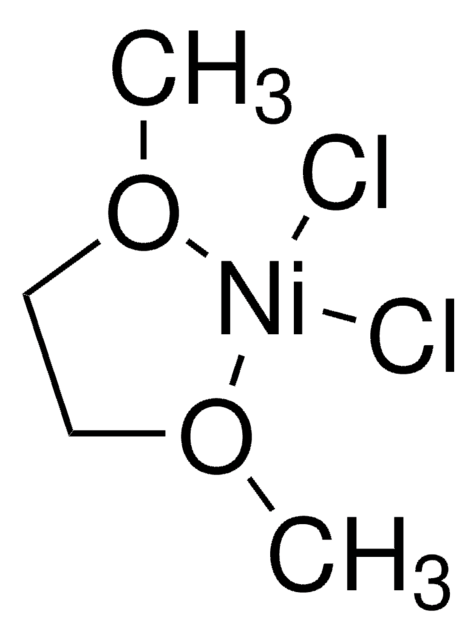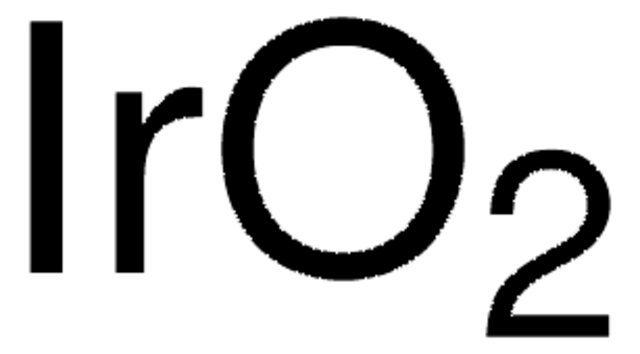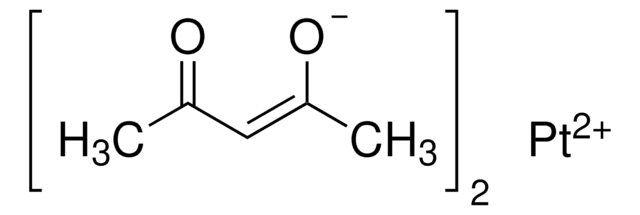추천 제품
Quality Level
분석
95%
양식
solid
반응 적합성
core: nickel
reagent type: catalyst
mp
230 °C (dec.) (lit.)
SMILES string
CC(=O)\C=C(\C)O[Ni]O\C(C)=C/C(C)=O
InChI
1S/2C5H8O2.Ni/c2*1-4(6)3-5(2)7;/h2*3,6H,1-2H3;/q;;+2/p-2/b2*4-3-;
InChI key
BMGNSKKZFQMGDH-FDGPNNRMSA-L
유사한 제품을 찾으십니까? 방문 제품 비교 안내
일반 설명
Nickel(II) acetylacetonate, known as bis(acetylacetonato)nickel(II) or Ni(acac)2, is a blue-green crystalline compound soluble in water. It finds application in catalysis, materials synthesis, and organic chemistry, playing a crucial role as a catalyst in various reactions and serving as an important precursor for the development of nickel-based nanomaterials and catalysts used in industrial processes and organic transformations.
애플리케이션
Nickel(II) acetylacetonate can be:
- Used as a precursor to synthesize Ni-based nanomaterials such as NiO/C nanocomposite and crystalline NiO nanoparticles via different synthetic methods like non-isothermal decomposition and solvothermal method.,·
- Used to prepare Ni catalysts such as Nickel(II) complexes, and hierarchical Ni/beta catalysts for various organictransformations.
- Nickel(II) acetylacetonate has several applications in catalysis: It is used as a catalyst for the polymerization of olefins and transesterification reactions.
- Nickel(II) acetylacetonate can be employed as a catalyst to promote Michael additions.
관련 제품
제품 번호
설명
가격
신호어
Danger
유해 및 위험 성명서
Hazard Classifications
Acute Tox. 4 Dermal - Acute Tox. 4 Oral - Carc. 1A - Muta. 2 - Resp. Sens. 1 - Skin Sens. 1
Storage Class Code
6.1C - Combustible acute toxic Cat.3 / toxic compounds or compounds which causing chronic effects
WGK
WGK 3
Flash Point (°F)
428.0 °F
Flash Point (°C)
220 °C
개인 보호 장비
Eyeshields, Faceshields, Gloves, type P2 (EN 143) respirator cartridges
이미 열람한 고객
Yueping Zhao et al.
Small (Weinheim an der Bergstrasse, Germany), 15(17), e1900288-e1900288 (2019-03-29)
The catalytic performance of Pt-based catalysts for oxygen reduction reactions (ORR) can generally be enhanced by constructing high-index exposed facets (HIFs). However, the synthesis of Pt alloyed high-index skins on 1D non-Pt surfaces to further improve Pt utilization and stability
Huiming Li et al.
Chemistry (Weinheim an der Bergstrasse, Germany), 24(45), 11748-11754 (2018-06-06)
The phase of nanocrystals has a key role in the modulation of catalytic properties. Uniform and well-crystallized nickel phosphide nanocrystals with controlled phases (Ni5 P4 , Ni2 P, and Ni12 P5 ) and narrow size distributions are synthesized by a
Lin Chen et al.
Nature communications, 8, 14136-14136 (2017-01-11)
Incorporating oxophilic metals into noble metal-based catalysts represents an emerging strategy to improve the catalytic performance of electrocatalysts in fuel cells. However, effects of the distance between the noble metal and oxophilic metal active sites on the catalytic performance have
Olli Pitkänen et al.
ACS applied materials & interfaces, 11(21), 19331-19338 (2019-05-07)
High-performance electromagnetic interference shielding is becoming vital for the next generation of telecommunication and sensor devices among which portable and wearable applications require highly flexible and lightweight materials having efficient absorption-dominant shielding. Herein, we report on lightweight carbon foam-carbon nanotube/carbon
Bowen Yu et al.
Nanotechnology, 25(32), 325602-325602 (2014-07-24)
Ni-assisted thermal chemical vapor deposition (TCVD) is one of the most common techniques for the growth of carbon nanofibres/nanotubes (CNFs/CNTs). However, some fundamental issues related to the catalytic growth of CNFs/CNTs, such as the low-limit growth temperature, the limiting steps
자사의 과학자팀은 생명 과학, 재료 과학, 화학 합성, 크로마토그래피, 분석 및 기타 많은 영역을 포함한 모든 과학 분야에 경험이 있습니다..
고객지원팀으로 연락바랍니다.













